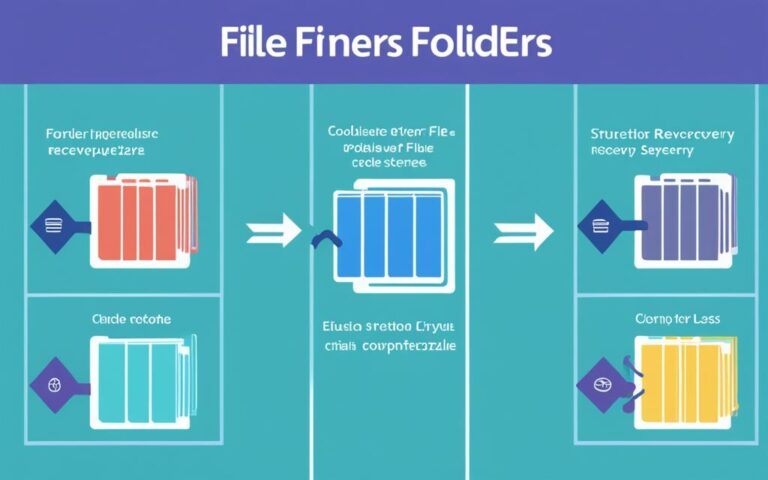How to Prevent Data Loss in the First Place
Data loss can have severe consequences for businesses, including financial loss, damage to reputation, and compromised customer trust. It is essential for organizations to take proactive measures to prevent data loss and protect their valuable digital assets. By implementing effective data loss prevention strategies, businesses can minimize the risk of data breaches, unauthorized access, and other forms of data loss.
Here are some Data Loss Prevention Tips and strategies that can help:
- Regularly back up your data to ensure that you have a copy in case of accidental deletion, hardware failure, or cyber attacks.
- Implement robust hardware protection measures, such as firewalls, antivirus software, and intrusion detection systems, to safeguard your network and devices.
- Educate your employees about the importance of data security and provide training on how to handle sensitive information responsibly.
- Encrypt sensitive data to make it unreadable in the event of unauthorized access or data breaches.
- Control access to your data by implementing strong authentication mechanisms, such as multi-factor authentication and role-based access controls.
By following these Data Loss Prevention Strategies, businesses can significantly reduce the risk of data loss and ensure the confidentiality, integrity, and availability of their data. Building a culture of security awareness and regularly updating software and systems also play a crucial role in preventing data loss.
What is Data Loss Prevention (DLP)?
Data Loss Prevention (DLP) is the practice of using tools, techniques, and technologies to prevent sensitive data from being stolen, damaged, or misused through data breaches, unauthorized access, or illegal exfiltration. DLP helps enforce data security by providing mechanisms for classifying data, prioritizing protection, and ensuring compliance with regulatory requirements. By implementing a comprehensive DLP strategy, businesses can reduce the risk of intentional or accidental data compromise and ensure the confidentiality, integrity, and availability of their data.
Ways to Prevent Data Loss
Preventing data loss is essential for safeguarding your valuable digital assets and protecting sensitive information from unauthorized access or theft. Implementing effective data loss prevention measures can significantly reduce the risk of data breaches and ensure the integrity and confidentiality of your data. Here are some key strategies to consider:
1. Regular Data Backups
Performing regular backups of your data is crucial. This ensures that even if data loss occurs, you can restore your information from a previous backup. Choose a reliable backup solution and schedule automated backups to minimize the risk of human error. It’s essential to store backups in a secure location, preferably offsite or in the cloud, to prevent potential physical damage or loss.
2. Implement Robust Access Controls
Controlling access to your data is vital for preventing unauthorized users from gaining entry. Implement strict access control measures, such as strong passwords, multi-factor authentication, and role-based permissions. Regularly review and update access privileges to ensure that only authorized individuals can access sensitive data.
3. Encrypt Sensitive Data
Encryption provides an additional layer of security by transforming data into unreadable formats, making it inaccessible to unauthorized individuals. Implement encryption protocols for sensitive data, both at rest and in transit. This prevents data breaches and protects information even if it falls into the wrong hands.
4. Train and Educate Employees
Human error is a common cause of data loss. Providing comprehensive training and education to employees on data security best practices is essential. Teach them about the importance of strong passwords, safe browsing habits, and identifying and reporting potential security threats. Encourage a culture of security awareness and make sure employees understand the potential consequences of data loss.
5. Implement Data Loss Prevention Software
Data loss prevention (DLP) software enables proactive monitoring, detection, and prevention of data breaches. It helps identify and classify sensitive data, enforce security policies, and prevent data loss through various channels. Implementing DLP software can help organizations stay ahead of evolving threats and ensure the protection of critical data.
By incorporating these preventive measures into your data management strategy, you can significantly minimize the risk of data loss and enhance the overall security of your digital assets.
Importance of Building a Security-First Culture
Building a security-first culture within an organization is crucial for preventing data loss and enhancing overall data security. It involves breaking down silos and fostering a sense of shared responsibility for security throughout the company. By integrating security at all stages of the business, from top management to operations, employees are better equipped to prevent data breaches.
“A strong security-first culture is the foundation of a secure environment. It creates a mindset where data security awareness becomes ingrained in every employee, enabling proactive identification and mitigation of potential threats.”
A security-first culture starts with leadership setting a strong example and prioritizing security measures. By providing regular training and education, organizations can raise data security awareness among employees, empowering them to recognize and respond to security risks effectively.
Building a secure environment requires collaboration, communication, and a commitment to continuous improvement. Encouraging an open culture that promotes reporting and addressing security incidents without fear of reprisal helps create a safe and secure work environment.
Implementing policies and procedures that enforce security measures, such as secure access controls, strong authentication protocols, and encryption, is essential. Regular security audits and risk assessments should be conducted to identify vulnerabilities and implement appropriate measures to mitigate them.
- Promote a security-first mindset across the organization
- Invest in regular cybersecurity training and education
- Establish strong access controls and authentication protocols
- Encourage reporting of security incidents without fear of reprisal
- Conduct regular security audits and risk assessments
By establishing a security-first culture, organizations create a strong foundation for data protection. This not only reduces the risk of data loss but also enhances customer trust and strengthens the company’s reputation.
Securing Database Access to Prevent Data Loss
Properly securing database access is critical for preventing data loss, as databases often contain sensitive and valuable information. By implementing effective database security measures, businesses can significantly reduce the risk of unauthorized access and data breaches.
Database Security Best Practices:
- Implement strong authentication methods: Use robust password policies and enforce two-factor authentication to ensure that only authorized individuals can access the database.
- Apply least privilege principle: Grant users the minimum level of privileges necessary to perform their tasks. This prevents unauthorized access and reduces the impact of potential security incidents.
- Regularly update and patch the database: Keep the database software and associated applications up to date with the latest security patches and updates to address any potential vulnerabilities.
- Encrypt sensitive data: Implement encryption techniques to safeguard sensitive data stored in the database. This provides an additional layer of protection, even if the data is compromised.
- Monitor and audit database activities: Regularly review and analyze database logs for any suspicious activities or anomalies. Implement real-time monitoring to promptly detect and respond to potential security threats.
By adhering to these best practices, businesses can strengthen their database security and minimize the risk of data loss due to unauthorized access, breaches, or other vulnerabilities.
Additional Measures to Prevent Data Loss
In addition to the previously mentioned strategies, there are several additional measures you can take to prevent data loss and enhance your overall data security. These measures are particularly effective in reducing human error, a common cause of data loss.
1. Implement Regular Data Backups
Regularly backing up your data is essential for protecting against data loss. Make sure to automate the backup process to ensure consistency and reliability. Store your backups in secure, off-site locations to safeguard against physical damage or disasters.
2. Utilize Data Loss Prevention Software
Data loss prevention (DLP) software can help you identify, monitor, and protect sensitive data across your network. It includes features such as data encryption, access controls, and activity monitoring to prevent unauthorized data leakage.
3. Enforce Strict Access Control Policies
Implement strict access control policies to limit access to sensitive data only to authorized personnel. Use strong passwords, multi-factor authentication, and role-based access controls to ensure that only those who need access can obtain it.
4. Conduct Regular Employee Training and Education
Reduce the risk of human error by providing comprehensive training and education to your employees. Make sure they understand the importance of data security and the actions they can take to prevent data loss, such as safe browsing practices, email encryption, and proper handling of sensitive information.
5. Monitor and Audit Data Access
Implement monitoring and audit mechanisms to track data access and identify any suspicious or unauthorized activities. Regularly review access logs and investigate any anomalies to ensure the security of your data.
6. Encrypt Sensitive Data
Encrypting sensitive data adds an additional layer of protection, making it unreadable and useless to unauthorized individuals. Utilize encryption algorithms and secure key management practices to protect your data at rest and in transit.
By implementing these additional measures, you can further strengthen your data loss prevention efforts and reduce the risk of data breaches and other data loss incidents. Remember, preventing data loss requires a combination of technological solutions, employee awareness, and ongoing vigilance.
Conclusion
Preventing data loss is essential for businesses in the United Kingdom to protect their digital assets and ensure business continuity. By implementing effective data loss prevention strategies, such as regular backups, hardware protection, employee education, encryption, and access controls, businesses can significantly minimize the risk of data breaches, unauthorized access, and other forms of data loss.
Building a security-first culture and incorporating security measures throughout the organization further enhances data security. It involves breaking down silos and fostering a sense of shared responsibility for security. By integrating security at all stages of the business, from top management to operations, companies equip their employees to take proactive measures in preventing data breaches.
It is important to regularly update software, enforce strong passwords, and utilize data loss prevention software to safeguard data. Businesses should also stay informed about the latest trends and technologies in data security to adapt their prevention strategies accordingly. With these comprehensive measures in place, businesses can effectively safeguard their data and mitigate the potential consequences of data loss.












